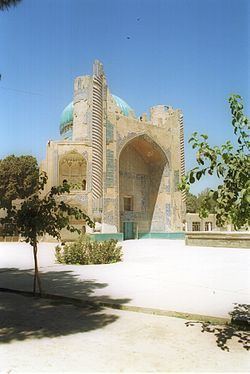Location Balkh, Afghanistan Architectural style Timurid Architecture Opened 1421 Number of minarets 2 Groundbreaking 1419 | Affiliation Islam Completed 1421 Leadership Shahrukh Mirza Architectural type Mosque Burials Khwaja Abu Nasr Parsa | |
 | ||
Materials Lapis lazuliBrick, Stone Similar Khost Mosque, Khwaja 'Abd Allah Ansari sh, Pul‑e Khishti Mosque, Shah‑Do Shamshira Mosque, Lashkargah Mosque | ||
Green mosque balkh
The Masjid Sabz or Green Mosque is a mosque in the city of Balkh, in northern Afghanistan. It is believed to have been commissioned by the then ruler of the Eastern Timurid Empire, Shah Rukh, or by his wife Goharshad.
Contents
History
After Tamerlane's death in 1405, his empire fell apart with various tribes and warlords competing for dominance. The Black Sheep Turkmen destroyed the western empire in 1410 when they captured Baghdad, but in Persia and Transoxiana Shāhrukh was able to secure effective control from about 1409. His empire controlled the main trade routes between East and West, including the legendary Silk Road, and became immensely wealthy as a result. His wife, Gowhar Shād, funded the construction of many outstanding mosques and schools throughout khorasan (western Afghanistan and eastern Persia) the most secure portions of the empire. It was during these times of stability that many architectural masterpieces where constructed. In the 1640s Mughal Prince Shah Jahan was stationed in the Balkh Province due to Uzbek incursions. Shah Jahan has been known in the region to have had made adjustments to many of the local mosques and borrowing ideas for his own buildings that he built throughout his reign, also aspects of this building are a precursor to the famous Taj Mahal, as the similarities can be seen.
Architecture
The main building displays a typical Timurid architectural style. However, today much of the building itself has suffered heavy from neglect and damage by warring factions during the Soviet and Afghan civil wars. The main courtyard has been well preserved allowing people to pray in the open spaces. To the back of the building however little care has been given to the paving and gardens. The minaret has either collapsed due to the age of the building or could have been the act of aggression during wartime by the communists. Much of the tile work has disappeared and the wooden doors are in dire need of repair.
